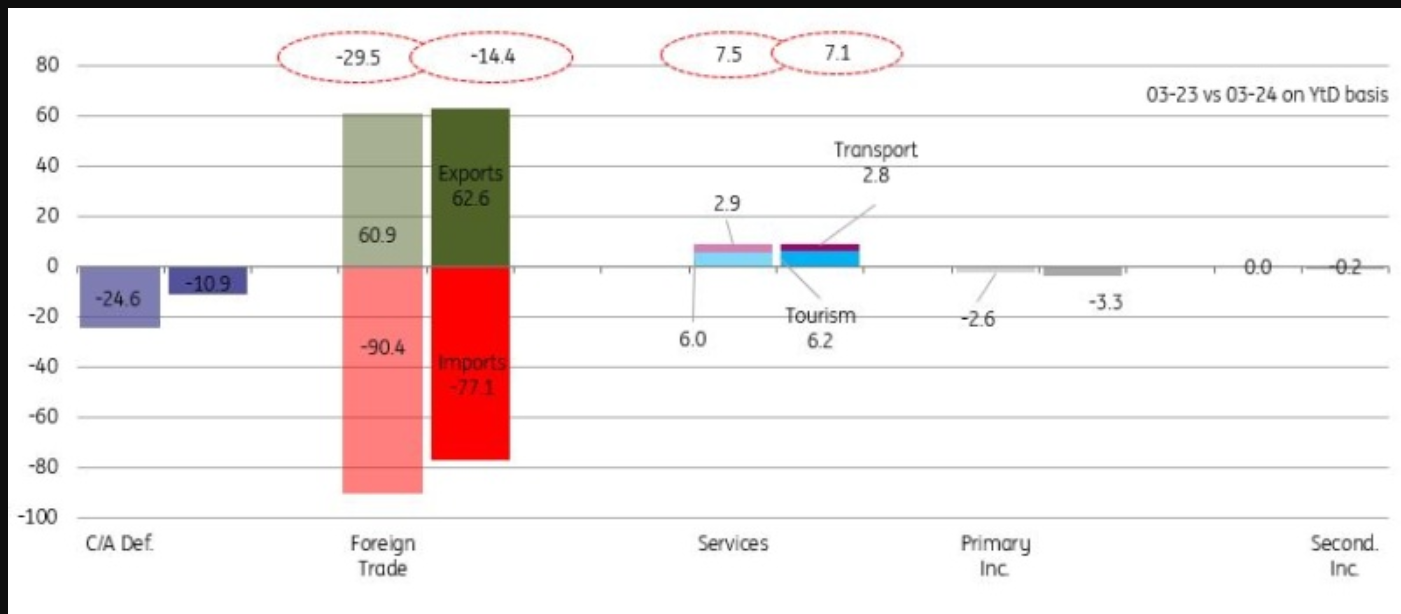The current account in March posted a deficit of US$4.5bn, while the improvement in the 12-month rolling deficit, which followed a faster pace in the first two months of the year, lost momentum with a modest decline to US$31.2bn (translating into c.2.8% of GDP) from US$31.9bn a month ago, remarked ING Research.
Capital flight continued at startling numbers via the “unidentified items” account, but banks and corporates borrowed amply in the month.
While preliminary April foreign trade data points to another monthly deficit of ca $3.5 bn, head-spinning increases in Central Bank’s gross and new FX reserves, amounting to $41 bn in 40 days suggest, capital flight has slowed down, while financial inflows accelerated.
Economy czar Mehmet Simsek promised further improvements in current account in his Monday X post.
The improvement in the current account deficit in March was attributable to the continuing recovery in the foreign trade deficit. But the downward trend that started after the peak last July has lost momentum, with only a slight decline in the 12-month rolling deficit over the previous month.
In the breakdown, compared to the same month of last year, we see:
A continuing recovery in the energy balance with a fall in the deficit to US$3.8bn from US$4.6bn.
The core trade balance has moved into surplus at US$0.1bn from a slight deficit of US$0.5bn.
While these two items determined the improvement in the current account, the widening gold trade deficit, slightly lower services and primary income limited the extent of the decline.
Startling capital flight via errors and omissions account
On the capital account, net identified flows remained weak with a mere US$3.8bn of inflows, falling short of the current account deficit again, following mild outflows a month ago. Errors and omissions outflows recorded significant outflows ahead of the March local elections at US$9.6bn, similar to what we saw during the financial volatility of December 2021 (US$10.6bn) and before the May 2023 presidential election (US$9.6bn). With the monthly current account deficit and weak flow outlook, official reserves recorded a US$10.3bn decline.
In the breakdown of monthly data, non-residents’ movements drove the inflows with:
US$2.3bn deposited by foreign entities in the banking system
US$0.7bn of trade credits
Continuing Eurobond issuances of banks at US$1.2bn and
Net borrowing at US$1.4bn.
In March, rollover rates stood at 121% for the corporates and 161% for the banking (vs 97% and 123%, respectively on a 12-month rolling basis).
Non-debt creating foreign inflows, standing at US$0.7bn thanks to (gross) FDI at US$0.4bn and purchases in the equity market at US$0.2bn.
Residents’ movements drove the outflows with portfolio investments at US$1.5bn, and outward FDI at US$0.6bn.
In the first quarter of 2024, no-resident inflows remained broadly unchanged in comparison to the same period of 2023 at around US$17bn, while asset acquisitions of locals abroad increased which contributed to a decline in net identified flows (US$4.3bn US$11.4bn last year). Outflows via net errors and omissions jumped to US$16.1bn vs US$1.1bn last year. Despite a strong recovery in the current account balance from US$-24.6bn to US$-10.9bn, official reserves plunged by US$22.7bn vs the US$14.3bn decline last year.
Fiscal saving measures announced
On the fiscal side, the Minister of Treasury and Finance, Mehmet Şimşek, announced a package of measures, which include cutting purchases of goods and services and investment spending to control the widening in the budget deficit and to help disinflation while he signalled additional actions in the period ahead. Accordingly, the government targets a budget deficit-to-GDP ratio this year close to the level realised in 2023 (5.2%) or lower. Simsek’s signal of increased support from fiscal policy for disinflation hints that the government prioritises spending freezes to control the fiscal deficit rather than revenue-boosting actions in the short term, and hence, there will not likely be a significant correction in electricity and natural gas prices until inflation is on a notable downward trend.
Follow our English language YouTube videos @ REAL TURKEY: https://www.youtube.com/channel/UCKpFJB4GFiNkhmpVZQ_d9Rg
And content at Twitter: @AtillaEng
Facebook: Real Turkey Channel: https://www.facebook.com/realturkeychannel/
